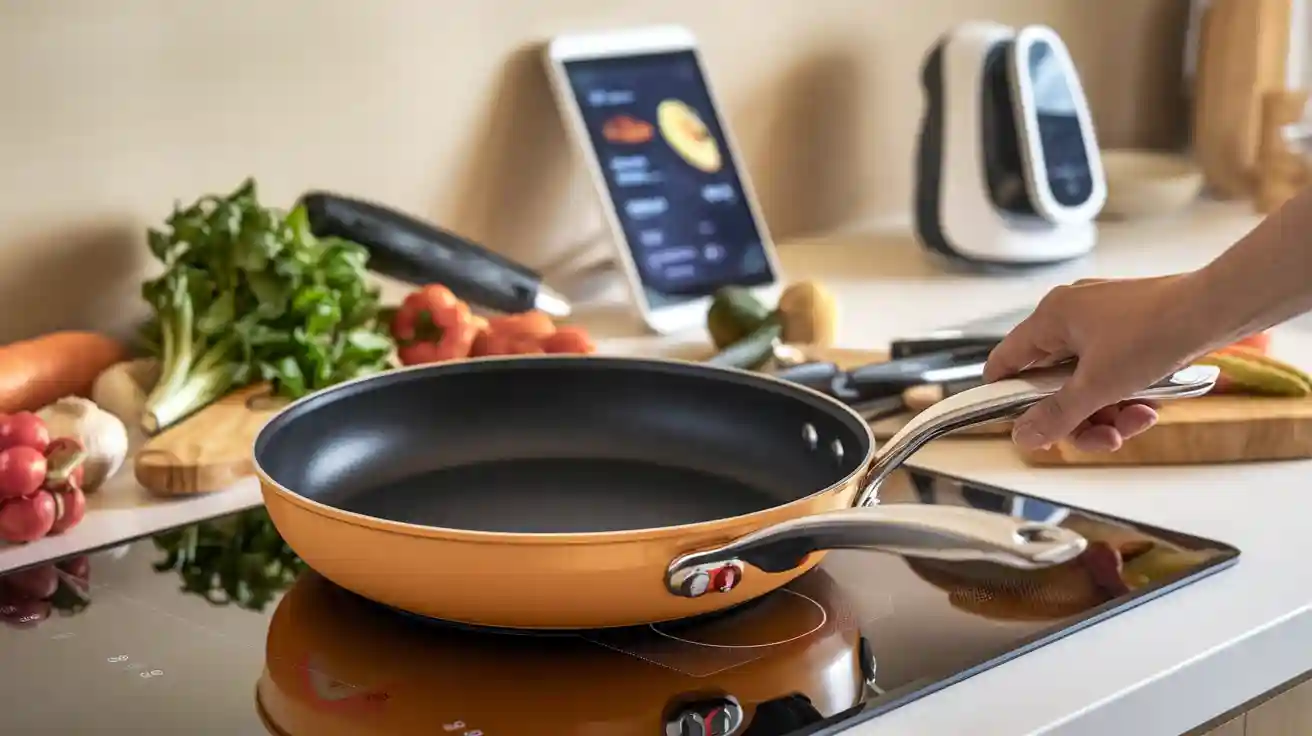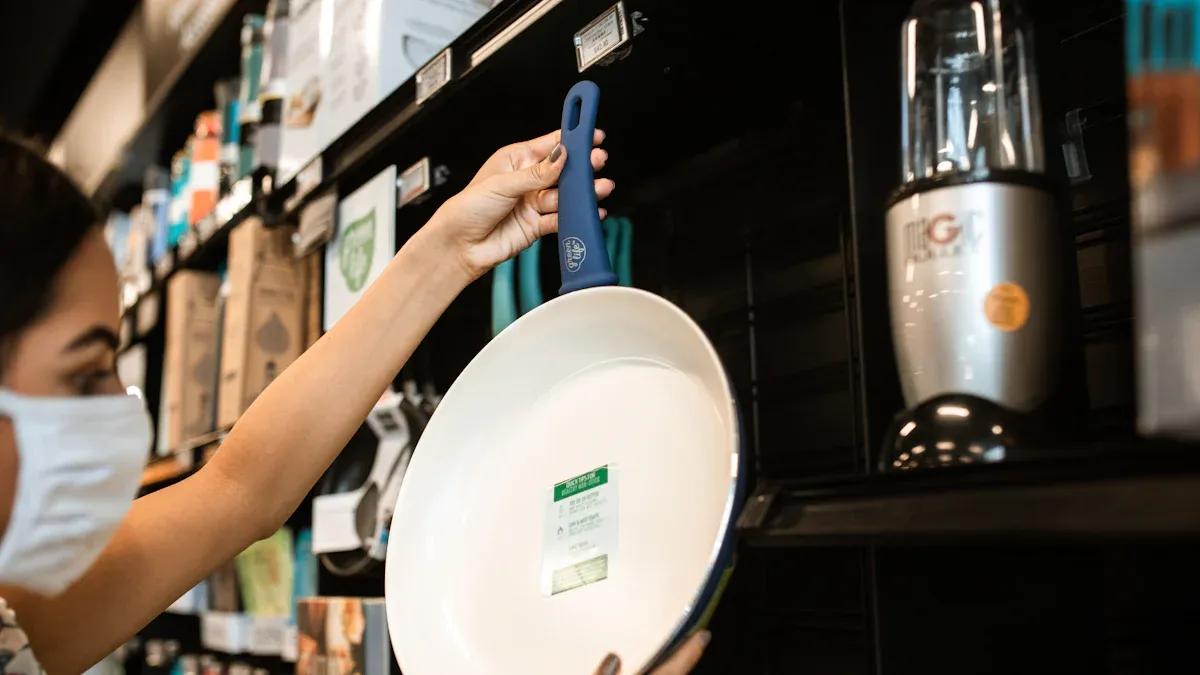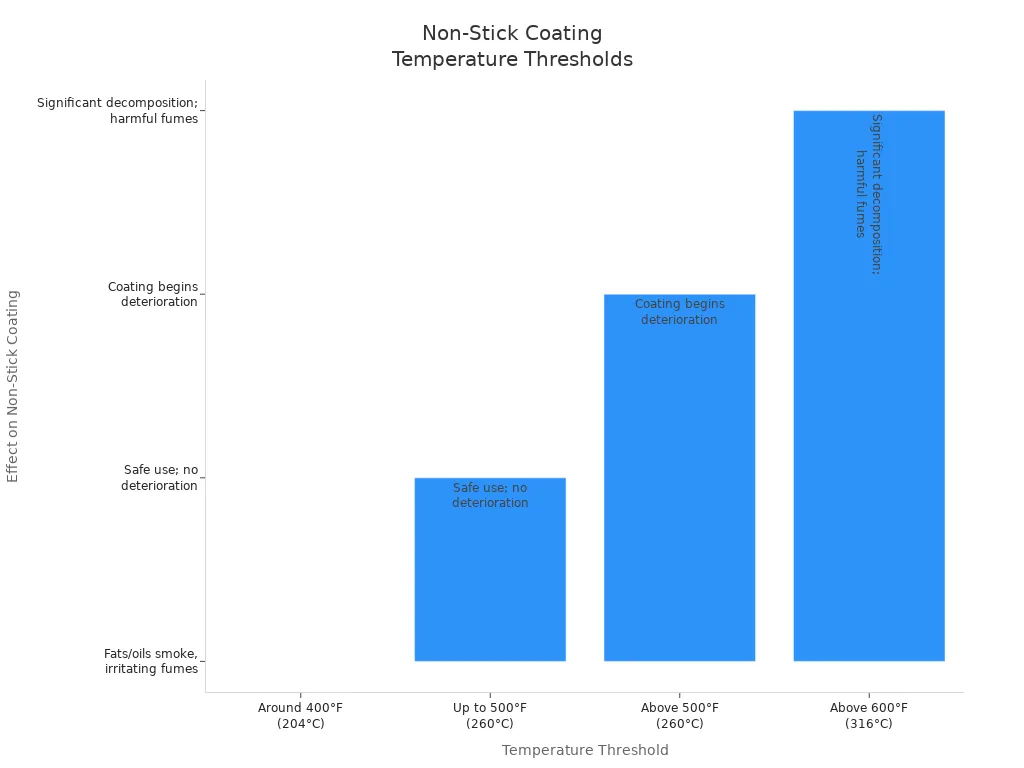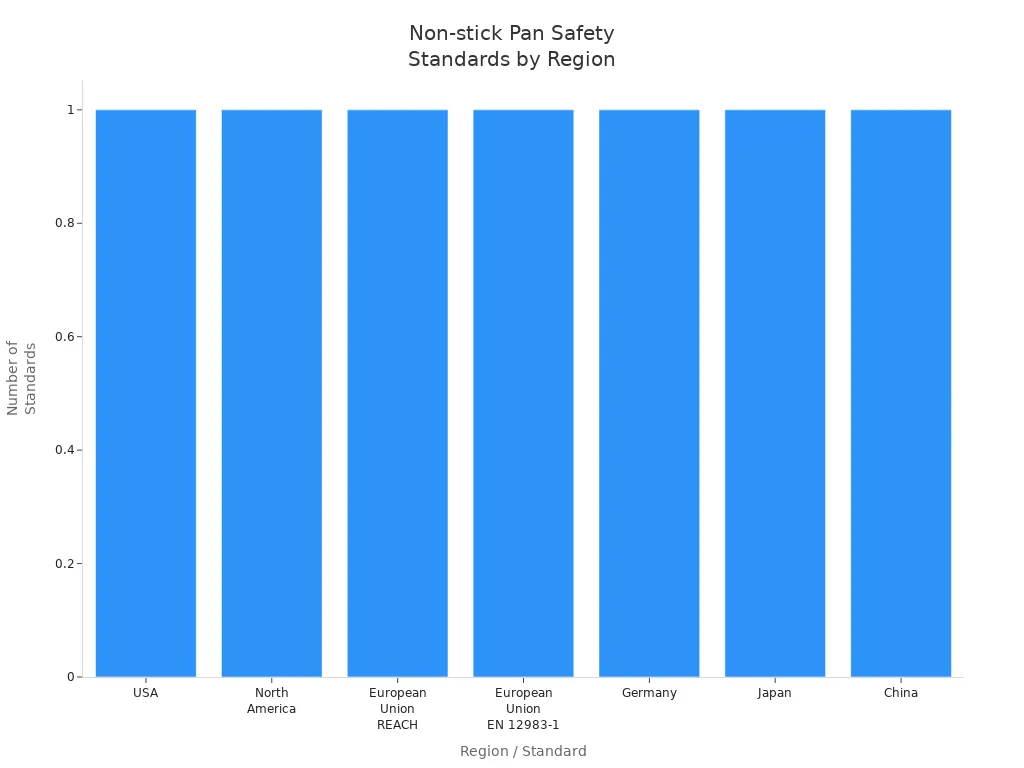
You choose non-stick frying pans for safer cooking at home. Non-stick coatings in the best non stick frying pan keep food from sticking and help you use less oil. Nonstick surfaces reduce risks from pfoa and overheating. Modern non-stick frying pans boost performance and make everyday cooking easy.
Engineering the Best Non Stick Frying Pan for Safety and Performance
Non-Toxic Nonstick Coatings and Safe Materials
When you look for the best non stick frying pan, you want to make sure it uses safe, non-toxic materials. Many non-stick frying pans now use coatings that do not contain harmful chemicals like PFOA or PTFE. You can choose from several safe options:
- Ceramic-coated cookware gives you a nonstick surface without PFOS, PFOA, or PTFE. This type of nonstick coating resists heat well and often works in the oven.
- Stainless steel pans do not have a chemical coating. They are durable and non-reactive, so they do not leach harmful substances into your food.
- Cast iron pans, when seasoned, create a natural nonstick surface. You get excellent heat retention and a non-toxic cooking experience.
- Carbon steel pans work like cast iron but are lighter. They also develop a natural nonstick patina with seasoning.
- Glass cookware is non-reactive and safe, though you will not find it often as a frying pan.
These materials help you avoid the health risks linked to traditional non-stick coatings that use PFAS chemicals. Ceramic coatings, for example, do not release harmful fumes at high temperatures. They are free from PFAS, lead, and cadmium. However, ceramic coatings may wear out faster than PTFE, so you might need to replace them more often. PTFE coatings, known as Teflon, work well at normal cooking temperatures but can release toxic fumes if you overheat them. Scratches or high heat can also cause PTFE coatings to break down and release particles. By choosing non-toxic options, you make your kitchen safer for you and your family.
Advanced Temperature Control and Thermal Efficiency
Modern non-stick frying pans use advanced temperature control to keep your cooking safe and efficient. Many high-quality non-stick frying pans now include features that help you avoid overheating. Some pans have a Thermo-Spot heat indicator that changes color between 285°F and 380°F. This tells you when the pan is at the best temperature for frying or searing. You can also find pans that are oven safe up to 600°F, like the Oxo Ceramic Professional Non-Stick and the GreenPan Stanley Tucci Ceramic Nonstick.
| Product Name | Oven Safe Temperature Limit |
|---|---|
| Oxo Ceramic Professional Non-Stick | Up to 600°F |
| GreenPan Stanley Tucci Ceramic Nonstick | Up to 600°F |
| Oven safe with silicone sleeve | Up to 400°F |
| Oven safe without silicone sleeve | Up to 500°F |
These features help you avoid damaging the nonstick coating and keep your food safe. Modern non-stick frying pans also use heat distribution technologies to spread heat evenly. This means your food cooks faster and you use less energy. For example, a 3-in-1 Non-Stick Frying Pan heats up quickly and cooks food evenly. The Honeycomb Non-Stick Frying Pan uses a special design to make sure every part of your meal gets the right amount of heat. When you use a pan with good thermal efficiency, you save time and lower your energy bills.
Durable Construction and Scratch Resistance
You want your non-stick frying pans to last a long time and keep their nonstick performance. The best non stick frying pan uses strong materials like aluminum and stainless steel for the pan body. Aluminum heats up fast and spreads heat well, but it may not work on induction stoves unless combined with other materials. Stainless steel adds strength and helps with even heat distribution.
Some nonstick coatings are PTFE-based or ceramic. Both types can get scratched, especially if you use metal utensils. To make pans more durable, some brands add a slightly textured surface. This improves scratch resistance and helps the premium non-stick surface last longer. Hard anodized aluminum, like in the Cuisinart Chef’s Classic skillet, also boosts durability.
Tip: Use silicone or wooden utensils and avoid abrasive cleaning to extend the life of your nonstick coating.
Manufacturers test non-stick frying pans in many ways to check their quality. They use abrasion resistance tests with metal utensils, adhesion tests to see if the coating peels, and chemical resistance tests with kitchen acids and oils. Impact resistance tests check if the pan can handle drops. Hardness tests use pencils to measure scratch resistance. Non-stick performance tests cook foods like eggs without oil to see how well the food releases. Durability assessments include many cooking and cleaning cycles to make sure the nonstick coating keeps working.
A scientific study found that fluoropolymer coatings, like PTFE, perform better in durability and food release than ceramic coatings. However, no nonstick pan is completely scratch-proof. Over time, all coatings will wear down, especially with high heat or rough use. To keep your premium non-stick surface in top shape, replace your pan when you see signs of wear.
Innovations in Non-Stick Frying Pans for Safer Cooking
Multi-Layer Nonstick Coating Systems
You benefit from multi-layer non-stick frying pans because they use advanced nonstick coating systems that improve both safety and durability. These pans use safer materials like ceramic and anodized aluminum in their outer layers. This design reduces the risk of harmful substances being released at high temperatures. Multi-layer nonstick coatings also meet strict safety standards, which helps address health concerns linked to older single-layer PTFE coatings. You avoid toxic fumes and flaking because the layered structure prevents peeling and damage. Many brands now eliminate PFOA, making these non-stick frying pans safer for you and the environment.
- Multi-layer non-stick coatings usually last between 3 and 5 years with regular use.
- Some brands, such as Cuisinart and T-fal, use titanium or diamond particles to make the nonstick coating last even longer.
- Proper care, like avoiding metal utensils and high heat, helps extend the life of your nonstick frying pans.
- High-end brands use two or three layers of nonstick coating to improve quality and performance.
You get a safer, more durable, and environmentally friendly option for versatile cooking.
Ceramic and Diamond-Infused Non-Stick Surfaces
Modern non-stick frying pans often feature ceramic or diamond-infused nonstick surfaces. These advanced non-stick coatings offer chemical safety and long-lasting performance.
| Aspect | Ceramic Coatings | Diamond-Infused Coatings |
|---|---|---|
| Chemical Composition | Inorganic, no PTFE or PFOA | PFAS- and PFOA-free, diamond bonded |
| Chemical Safety | Safe at normal cooking temperatures | No flaking or leaching |
| Durability | Needs delicate care, may degrade faster | Highly durable, scratch-resistant |
| Risk of Toxic Fumes | Avoids toxic fumes | Avoids toxic fumes |
| Flaking or Leaching Risk | Possible over time | No flaking or leaching |
Diamond-infused non-stick frying pans use technology that bonds diamond crystals to the pan, making the nonstick coating more durable and safe. You avoid harmful chemicals and get a reliable nonstick surface for easy food release. Ceramic coatings are also PFAS-free and safe for your health, but they may wear out faster. Diamond-infused pans provide better heat distribution and scratch resistance, which means you enjoy quality cooking for longer.
Smart Pan Features and Hygienic Design
You find many modern non-stick frying pans with smart features that help prevent overheating and support hygienic cooking. Some pans use sensor-based controls and temperature monitors to keep your food at safe temperatures. Triply Kadai cookware uses a three-layer construction with an aluminum core and stainless steel layers. This design spreads heat evenly and prevents hot spots, which protects the nonstick coating and improves quality.
Hygienic design elements also play a big role in non-stick frying pans.
- Antibacterial coatings stop bacteria from growing, which keeps your cooking safe.
- The nonstick coating creates a smooth surface, making cleaning easier and reducing food residue.
- You should avoid metal utensils to protect the antibacterial properties of the coating.
- These features reduce odors and corrosion, helping your non-stick frying pans last longer.
Modern non-stick coatings and technology give you a safer, cleaner, and more reliable cooking experience with greater versatility.
Health and Safety Tips for Nonstick Frying Pans

Avoiding Harmful Chemicals and PFOA-Free Options
You want to keep your family safe when using non-stick frying pans. Always check labels for PFOA-free or PFAS-free claims. Ceramic-coated non-stick pans do not use PFOA, PFOS, or PTFE, so you lower your risk of chemical exposure. Stainless steel, cast iron, and ceramic pans are safer choices if you want to avoid the health risks of Teflon. Even though many non-stick pans claim to be PFOA-free, some PTFE-coated pans may still contain small amounts of PFOA or other PFAS due to manufacturing. To reduce your risk, choose ceramic or uncoated pans. PFOA has been banned in many places, but older or imported pans might still have it. Always inspect your cookware and replace it if you see flaking or damage.
Tip: Look for cookware labeled “0% PFAS” or “mineral coating without PTFE” for the safest non-stick options.
Preventing Overheating and Coating Damage
Overheating non-stick frying pans can cause the coating to break down and release harmful fumes. You should never preheat an empty nonstick pan on high heat. Always cook on low to medium heat and add oil or food before heating. Avoid using non-stick pans in ovens hotter than 500°F (260°C). The table below shows safe temperature limits:
| Temperature Threshold | Effect on Non-Stick Coating or Cooking Process |
|---|---|
| Up to 500°F (260°C) | Safe use; no deterioration of coating |
| Above 500°F (260°C) | Coating starts to deteriorate |
| Above 600°F (316°C) | Coating breaks down; harmful fumes released |
| Around 400°F (204°C) | Cooking fats/oils begin to smoke |

If you notice your nonstick pan smoking or discoloring, stop cooking and let it cool. Damaged or scratched coatings increase the risk of exposure to harmful substances. Following best practices for cooking with nonstick pans helps you avoid these dangers.
Safe Usage, Cleaning, and Maintenance
You can extend the life of your non-stick frying pans by following these steps:
- Handwash pans with mild dish soap and a soft sponge.
- Avoid abrasive scrubbers and harsh chemicals.
- Use wooden, silicone, or nylon utensils instead of metal.
- Let pans cool before washing to prevent thermal shock.
- Store pans separately or use pan protectors to avoid scratches.
- Avoid cooking sprays, which can degrade the nonstick surface.
- Replace pans if the coating flakes, peels, or food sticks even after cleaning.
Note: Proper cleaning and gentle use prevent coating damage and reduce health risks of Teflon. Using nonstick pans safely means you get better performance and a longer lifespan from your cookware.
By following these tips, you make cooking with nonstick pans safer and healthier for everyone in your home.
You benefit from modern non-stick frying pans because engineering, safety standards, and consumer demand drive innovation. Non-stick coatings now avoid harmful chemicals and meet strict regulations worldwide.

Non-stick pans with transparent materials, smart features, and eco-friendly designs help you cook safer. Choose non-stick cookware that matches your needs for health, durability, and performance.

FAQ
What utensils should you use with non-stick frying pans?
Use wooden, silicone, or nylon utensils. These materials protect the non-stick coating and help your pan last longer.
How do you know when to replace your non-stick frying pan?
Replace your pan if the coating peels, flakes, or food sticks even after cleaning. Damaged pans can release harmful substances.
Can you put non-stick frying pans in the dishwasher?
Handwashing is best. Dishwashers can damage the non-stick coating over time. Always check the manufacturer’s instructions for your specific pan.


